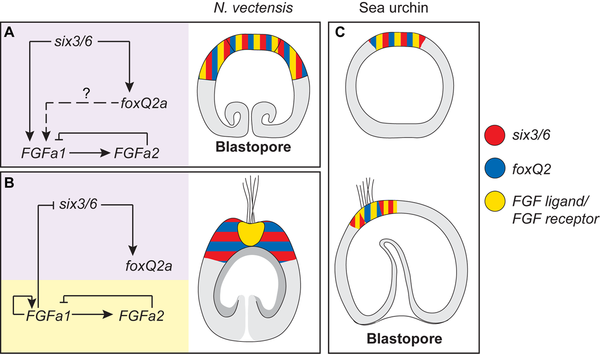In many animals, the brain is located in a specific structure like the head, along with sensory organs and often together with the mouth.
However, there are distantly related animals which have a nervous system but no brain, like sea anemones and corals.
In a new paper, the sea anemone Nematostella vectensis was used to find out if one of the ends of the sea anemone corresponds to the head of higher animals. To do this the researchers studied the function of genes that control head development in higher animals during the embryonic development of the starlet sea anemone.
"Despite looking completely different, it has become clear over the last decade, that all animals have a similar repertoire of genes, including those that are required to make the head of higher animals," says co-author Ulrich Technau from the University of Vienna.
When the sea anemones are in the larval stage they swim and search for a suitable site for settlement and metamorphosis into a polyp. During this metamorphosis, it is the front end of the larva, which senses the environment and attaches to the ground, while the other end, transforms into the oral side of the animal with mouth and tentacles.

A conserved anterior patterning system in Nematostella planula and sea urchin larva. (A and B) Model for gene regulatory network in place at gastrula and planula stages during aboral patterning of Nematostella larvae. At the gastrula stage (A), all the genes are co-expressed in the aboral area and NvSix3/6 positively regulates the expression of FGF ligands and NvFoxQ2a. The positive regulation of NvFGFa2 by NvFGFa1 is already in place, and it is likely responsible for the early restriction of FGFs' expression domains. At the planula stage (B), the aboral territory is divided in two domains, one surrounding the apical organ (in purple and blue/red) and one in the apical organ (orange and yellow). The first corresponds to the expression domain of NvSix3/6 and NvFoxQ2a (and NvFoxD1), the latter to the expression of FGF ligands (drawing). The regulatory interactions change at this stage and NvFGFa1 represses NvSix3/6; additionally, NvFGFa1 starts a positive autoregulation (direct or indirect), responsible for the maintenance of the FGF expressing area. (C) Segregation of expression domains in sea urchin larva. Similar to Nematostella gastrula, the genes are co-expressed at the contra-blastoporal (anterior) pole of sea urchin (data from Strongylocentrotus purpuratus and Paracentrotus lividus) at early blastula and then segregate in distinct domains from the mesenchymal blastula stage on, when the tuft of cilia appears. In this case, however, the genes segregate in a slightly different way: six3 forms a ring around the apical plate, while foxQ2 is restricted to the apical plate itself. The apical domain expression of the FGF receptor is restricted to the apical plate.
doi:10.1371/journal.pbio.1001488.g009
In contrast to everyone's expectation, the researchers found that the differentiation of the aboral (anterior) front of the sea anemone larva is governed by a hierarchy of genes, controlled by the upstream master control gene Six3/6. Notably, this gene as well its downstream dependent genes, also play a crucial role in setting up the field for making the brain of flies, fish and men.
Hence, the function of the "head genes" is located at the end that corresponds to the "foot" of the adult animals. "The anterior end of the swimming larva carries their main sense organ, so at this stage it looks more like this might be their head", says Rentzsch, the leader of the Norwegian research team. And indeed, the "head genes" function on this side of the animals, yet they are not (yet) used to form a full brain.
Sea anemones and all higher animals, including humans, share a common brainless ancestor, which lived between 600 and 700 million years ago. By revealing the function of "head genes" in Nematostella, the authors believe that they now understand better how and from where the head and brain of higher animals evolved. Definitely, the gene network that formed a sensory centre has been evolved in this common ancestor some 600 million years ago.
"Based on the appearance of the adult animals, the aboral end of these animals has traditionally been called the foot and the upper end the head, while in fact it is basically turned upside down", explains Technau. "Or we..."
Citation: Sinigaglia C, Busengdal H, Leclère L, Technau U, Rentzsch F (2013) The Bilaterian Head Patterning Gene six3/6 Controls Aboral Domain Development in a Cnidarian. PLoS Biol 11(2): e1001488. doi:10.1371/journal.pbio.1001488
Read also: Which Came First, the Head or the Brain? by Robin Mejia, PLoS Biology
10.1371/journal.pbio.1001484




Comments